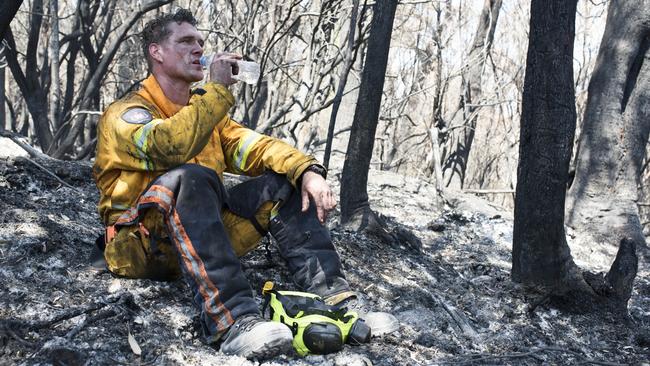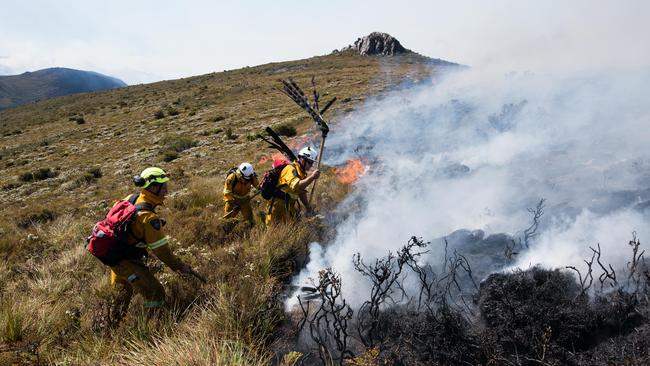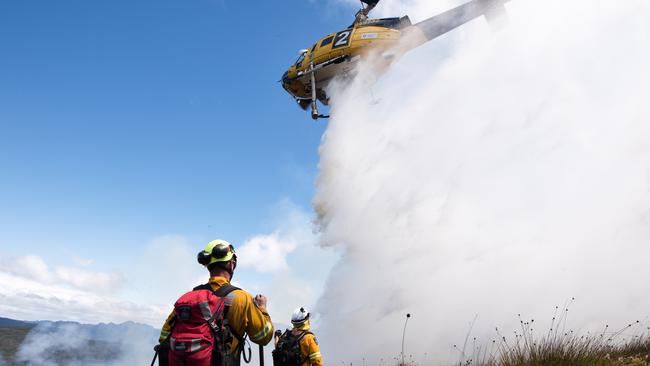Rex Gardner: Facing a sinister enemy
Tasmania’s cherished wilderness is ablaze, and there’s little we can do about it.

Opinion
Don't miss out on the headlines from Opinion. Followed categories will be added to My News.
TASMANIA’S cherished wilderness is ablaze, and there’s little we can do about it.
This fight against the powerful forces of nature is a David and Goliath affair.
As amazing as we humans think we are, we can only scratch around the edges when it comes to fighting massive bushfires in almost inaccessible terrain like the South-West.
There are dozens of small fires from lightning strikes burning at the moment.
NEWS: WARNINGS FOR TWO AREAS HIT BY CENTRAL PLATEAU FIRE
There are several major fires — and then there is monster Gell River fire, which has burnt out an estimated 20,000 ha.
Experts say these wilderness fires have a mind of their own. They are fickle by nature. And, if conditions worsen as predicted, the South-West fires could join forces with devastating effect on large tracts of wilderness and possibly small communities.
GALLERY: FIREFIGHTERS BATTLE DOZENS OF FIRES
Nature started this amazing and destructive show of force with lightning strikes several weeks ago. It has followed up with thousands more strikes over the past week setting off dozens of blazes in cherished pockets of wilderness.
Now only nature can seriously douse these fires. And, according to the experts, that could take weeks, or even months.

Sadly, our brave men and women in yellow overalls on the ground, their aerial support and the fire managers are seriously up against it.
How some opportunists can turn on our firefighters, their strategists and government in a crisis like this is beyond comprehension. The fireys won’t say anything publicly, but savage comments about their work cut deep.
NEWS: INTERSTATE CREWS BEEF UP FIRE FIGHT
The Gell River fire crews have been at it in incredibly harsh conditions for weeks, and now include 100 personnel and six aircraft. Thirty specialists from the NSW Rural Fire Service have flown in.
These lightning-strike fires are an act of nature. Ferocious weather and fires have ravaged Tasmania on and off (give or take an ice age) for hundreds of thousands of years. The landscape has been destroyed just like this over and over again.
It bounces back — but sadly, probably not in our lifetime. We are here for but a millisecond in the passage of time but are witnessing nature doing its thing first hand.

Our favourite walking tracks through the South-West may now go through blackened landscapes, but it is not the end of the world in the grand scale of things.
One of our leaders in the field, professor of pyrogeography and fire science David Bowman, says “nature was at war with us”.
“What a formidable enemy, to draw us into battle with all our resources and all of our focus on the Gell River fire, then the enemy starts all these other fires,” Prof Bowman, from the University of Tasmania, said.
“The enemy then turns off the rain and starts more fires.”
Firefighters were essentially doing triage — making commitments and choices about where to deploy services.
It was a “warlike situation and it was unprecedented,” Prof Bowman said.
More people on the fire front was the tip of an iceberg. That meant additional resources required to support them, such as more people feeding them, resourcing them, more aircraft, more servicing crews, and so on.

“The lack of rain, the lightning strikes, the heatwaves — that’s the reality. It is ugly, and there has to be triage.” Prof Bowman said.
Prof Bowman is encouraging more community discussion about fire preparedness. Because of climate change the community really needed to understand changing circumstances, and the “trajectory we are on”.
Tasmanian Fire Service Operations Officer Mark Klop said many of the South West fires were in such remote and inaccessible country firefighters could not get near them.
Even aerial firebombing was difficult in areas where tall trees with dense canopies stopped water penetrating the ground fire.
Fire operations strategists identified and prioritised fires and sent crews to those fires they could reasonably access.

Other fires burn on until crews can get to them.
“We have a lot of fire on the landscape already; more like what we usually get towards the end of January and into February,” Mr Klop said.
Mr Klop praised crews — many who were volunteers — who had spent weeks out in the rugged terrain away from families and the home comforts.
They worked in incredibly harsh wilderness conditions, sometimes making painfully slow headway.
Of the armchair critics, he diplomatically said: “Please, if you are going to make comment or complain that it is easy to put these fires out, ask the right questions and get a better understanding of the situation.”


